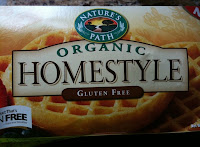Udi's Frozen Bagels
Before finding out about my gluten intolerance, bagels were one of my absolute favorite treats. Nothing could be more delicious than a freshly baked, warm bagel with my topping of choice. I went six months without one, thinking I would have to suffer a bagel-free existence for the rest of my life when, on New Year's Day, my brother brought in a fresh bag of bagels for everyone to enjoy. I nearly cracked and dove into one of the gluten-y beasts, when I realized this would be the thing that would kill my gluten-free resolve if I did not find a replacement AND SOON. Enter: Udi's.
I found them in the frozen section of my Stop N Shop and decided to give them a shot. Very simple - put them in the toaster, let them heat on up or toast to your liking and add the topping of choice. I have had Earth's Balance buttery spread, honey, jelly, all different types of nut butters (when looking for a little more protein in my quickie breakfast), and one morning, when I had more time on my hands, I even made myself a nice egg sandwich.
Udi's has a lot of gluten-free products to choose from and they are even nice enough to give you a coupon! Check out the Udi's Gluten-free site to get your $1 off coupon right now.
Gluten Free Waffles & French Toast
Don't put that toaster away yet! (These are quickie-breakfast options, don't forget.) My first ever gluten-free quickie breakfast buy was Nature's Path frozen waffles. These are quick, yummy and with the right syrup just darn delectable! I prefer the Homestyle version myself, but there are options for you to choose from (Buckwheat Wildberry or "Mesa Sunrise").
On the Nature's Path website, you can check out all the other gluten-free products available, including a number of kid-friendly bars and snacks.
Another company to take note of is Van's Natural Foods. They also have their own gluten-free waffle options (I have not yet tried them), as well as gluten-free french toast. The Cinnamon French Toast sticks smelled absolutely wonderful as they warmed up in my toaster (I am a sucker for the cinnamon scent!). While the "toast" itself seemed thinner than your average slice of bread, it was large in flavor. I will be getting these again. To see what other products Van's has to offer, or where you can buy your own French Toast, check out the Van's Natural Foods website.
Cereal!!
Nothing says you're crushed for morning time like a good old bowl of cereal. I have come to like Barbara's Gluten free Honey Rice Puffins. I usually have them with either my hazelnut milk or almond milk, but, again, this is up to your own liking (and restrictions, if you have any). You can check out Barbara's bakery's website for more information on their product offerings, coupons, recipes and even a link to their appearance in a Bon Appétit article on healthy cereals.
Barbara's is not, by far, the only gluten-free cereal on the market. (Here is an article about various gluten-free cereals from About.com.) Also, while there are many labeled gluten-free cereals, don't forget the old standbys that just may be gluten-free by default. To illustrate this point, you made have noticed the recent ad campaign by Chex cereals stating, "Hey guys! Wait a second - many of our cereals are gluten-free, too!!" The point is read ingredient labels, and, to be extra vigilant, call the company of any non-labeled cereal that you would like to try out (always double-check for possible cross-contamination if you have a sensitivity or intolerance!).
Et Cetera...
As we get swept up in doing our capitalist duty of buying packaged products from the local supermarket, let's not forget all the other gluten-free wonders on the go in the produce aisle! Please don't forget your fruits, nuts and seeds that are always ready and waiting for you to just gobble them up no matter how crunched for time you happen to be. Most require little to no preparation (a rinse, a peeling, maybe...) so they are the quickest, cleanest breakfasts that you can find and they are gluten free! So get out there and start finding out which fruits are your favs and make sure you always have them on hand.
What is YOUR favorite breakfast on-the-go?










